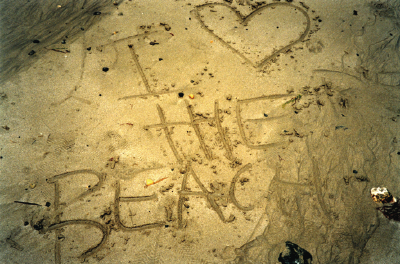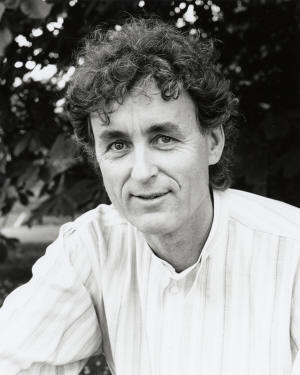 |
||
| home | features | exhibitions | interviews | profiles | webprojects | gazetteer | links | archive | forum | ||
|
|
||
|
Wishes In The Sand Rebecca Weeks reflects on art, physics and magic
Kathy Karpilov,
singer-songwriter and performance artist, and I were walking on the
beach in Penzance talking about quantum physics and ‘being’ as Heidegger
understood it. We were discussing the process of observation affecting
outcomes on a molecular level. We both find it fascinating that if
someone anticipates a particle as a wave it may In retrospect, I realise that to draw a parallel between physics and magic opens up a discussion of the dialogue between humanity and the universe; in which the world influences us and we in turn influence the world, and where we oscillate inside and outside of ourselves in response to, or in forming, reality. The potential for us to influence the reality around us may seem fantastical, and yet seems less so the more one questions the distinction between a scientific and a magical understanding. As some scientists have come to realise: The exploration of the sub-atomic world has revealed a reality that repeatedly transcends language and reasoning, and the unification of concepts that had hitherto seemed opposite and irreconcilable turns out to be one of the most startling features of this new reality. (Capra: 1982:161) Like mysticism, science has reached a state where things are sensed and spoken of which cannot be physically experienced. We have to have faith in science like one must have faith in magic. A discussion of ‘being’ takes us towards an edge, an edge of perception and understanding. An edge where language, reflective as it is of established thought patterns is inadequate, as the four dimensional world of relativistic physics is a world where force and matter are unified; where matter can appear as discontinuous particles or as a continuous field. In these cases we can no longer visualize the unity very well. Physicists can ‘experience’ the four dimensional space – time world through the abstract mathematical formalism of their theories, but their visual imagination like everybody else’s – is limited to the three dimensional world of the senses. Our language and thought patterns have evolved in this three dimensional world and therefore we find it extremely hard to deal with the four dimensional reality of relativistic physics.
Such a variable reality becomes easier to understand when we think about something like a shadow, which exists but has no fixed length. The length varies depending on time of day or the angle of the sun and the position of the person to whom it is attached. In writing about the parallels between magic and quantum physics, I realise that these disciplines are not just different approaches to knowledge; they in themselves are narratives, describing the world around us. Both are versions of reality that reach a point where existent logics do not suffice to explain all that ‘being’ encompasses. When we discuss the edges of reality I am aware that we enter into story telling, into the creation of a new version of events, a new model for how things work. Everything seems charged with new potentials. When we attempt to weave a new narrative of 'being' we enter into the mythic role of creator, simultaneously we are engulfed in the stuff of our stories, the difference between the story and the world can seem negligible, because the story of our time is all we have to guide us. Psychotherapy as part of today's story discusses reality as mutable and unfixed. Malcolm Parlett’s writing on ‘field theory' illustrates this and the key importance of understanding the dialogue that forms reality:
As a general outlook, a way of talking about and making sense of human experience, field theory attempts to capture the interrelated flow of unfolding human reality, impregnated as it is with our personal meanings and significance. Because we are most of us, members of families, communities, social groups, organisations, it is also a vehicle for exploring ourselves in relationship. There is no sharp cut-off between ‘internal’ and ‘external’; the unified field is the meeting place of the two. (Parlett: 1991:78)
A holistic perspective extends from the person to include environment, the social world, organisations, and culture. We are led to acknowledge the oneness of things and our dialogue with the cosmos that shapes the reality we inhabit. It also becomes apparent that to not be at one with our environment leads to alienation; to a deadening that is characteristic of many peoples experience of contemporary life. Alienation creeps over people who are disconnected from the places they inhabit, and grips people when they cannot relate to the ‘field’ of their environment leading to a feeling of total reification. In this non - life everything is an object, alien, people are objects too, alienated “things” in a world of other, equally meaningless things. This world is not of their making, the cosmos cares nothing for them, and they do not really feel a sense of belonging to it. The widespread experience of alienation in contemporary culture is evidence enough of the need to belong, to have a sense of dialogue with the world. Magic, and religion have traditionally offered that capacity to people, the ability to influence the fates, to heal, to protect, to give thanks and to talk to the cosmos in the everyday through simple acts of growing, hunting and preparing food, of marking the seasons and celebrating the stages of life. The challenge of modern life is to reclaim magic, to find ways to belong, to understand the narratives of our time, to root ourselves firmly in a dialogue with the world around us and to understand that we are all shaping reality all the time in subtle ways.
The experience of
life often lies beyond the rigidity of binaries or “the dialectics of
yes and no which decide everything Magic, physics and Art reach out into the unknown, as does all knowledge. All we have ever had are working models which explained some of the mysteries sufficiently for a time, until someone came across a new piece of the jigsaw, which we didn’t know we didn’t have, as no one knows what the finished puzzle looks like. That is to assume there is a fixed order or an answer to be found. The consideration of wishes and ‘field theory’, with their implications with regards to the effects of a being’s actions upon all of us leads me to believe we are involved in shaping the reality around us as a part of a dialogue which is underway all the time between all things in the cosmos and that there is no fixed outcome and no answer, the process is the answer or the outcome. This understanding does away with alienation because within it we all contribute to and are part of the flux that shapes reality. We all have the power to reconnect to each other and to the earth through this understanding and to potentially change the world around us for the better through embracing our ability to move beyond the constraints of a status linked understanding of power, towards a state where individuals have a sense of self worth that derives from understanding themselves as part of the whole, as belonging to the cosmos and as practicing citizens of a magical universe.
References Bachelard, Gaston, 1969, The Poetics Of Space, Beacon Press, New York Capra, Fritjof, 1982, The Tao Of Physics, Flamingo, London Parlett, Malcolm, 1991, Reflections On Field Theory, The British Gestalt Journal, www.britishgestaltjournal.com
Additional Bibliography Bachelard, Gaston, 1969, The Poetics Of Space, Beacon Press, New York de Certeau, Michel, 2000, The Practice Of Everyday Life, University of California Press, Los Angeles Heidegger, Martin, 1962, Being And Time, Blackwell publishing, Oxford
Hillman, James,
2005, Aesthetics And Politics, Tikkun
Magazine, www.home.net/archetypalpsychology/HillmanAestheticsPolitics.html |
||

